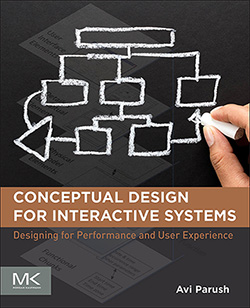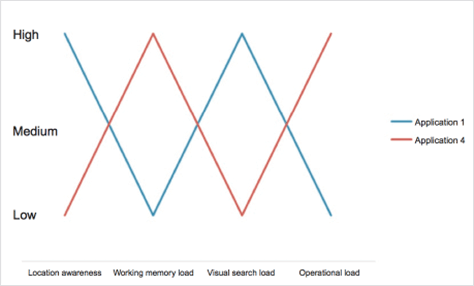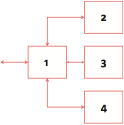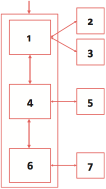There are strong connections between human performance and usability. A simple example can illustrate this: assume that a user has difficulties in reading some information off a display. This is an issue with perception and possibly some cognitive aspects related to comprehension. Such a degraded perceptual and cognitive process could result in reduced effectiveness of the user’s interaction with the application. Thus, human performance can directly affect usability and user experience.
The discussion of why conceptual models matter focuses on five fundamental human psychology and performance factors that play a role in any interaction. This focus illustrates how the configuration of functional chunks, places, and routes underlying the UI can influence performance.
Use the following five human performance factors to assess implications of conceptual models:
- Mental models and understanding
- Location awareness
- Visual search effectiveness
- Operational (executing actions) load
- Working memory load
1. If you understand it, you can use it!
The user interface of any interactive product or system should be such that we understand it. In order to understand, we need to develop and keep a mental representation of what we deal with—be it another person, a situation, an artifact they use, or an action they take. People construct mental structures, or mental models, to represent what they know. The mental structures typically consist of elements and the links between them. The elements could be words, concepts, images, names, places, episodes, experiences, and actions. A person’s knowledge on a topic comprises elements and their links. Some links are strong; others are weak. When interacting with an artifact, the user either starts with a preexisting mental structure about that artifact or constructs a new one based on the interaction and experience with the artifact. When one’s preexisting mental structure corresponds with the structure of the artifact one interacts with, it is easier to understand. Alternatively, if a user does not have a preexisting mental structure, the artifact should convey a structure that will facilitate understanding and the construction of a corresponding mental structure. The configuration underlying the user interface is composed of functional chunks, places, and routes. It conveys information that users can utilize in constructing their mental representation and understanding better the product they interact with. The methodology part of the book will address the challenge of matching the conceptual model to users’ mental models.
On Mental Models
Norman refers to one’s understanding when interacting with an artifact as “having a conceptual model of the device you interact with” (Norman, 1983, 1988, 1999, 2004). The internal, psychological representation of this model is often referred to as the user’s model or a mental model. To quote Norman’s definition: “Mental models [are] the models people have of themselves, others, the environment, and the things with which they interact. People form mental models through experience, training, and instruction. The mental model of a device is formed largely by interpreting its perceived actions and its visible structure” (Norman, 1988, p. 17). Hollnagel (1988) suggested that a mental model is the operator’s knowledge about his or her environment and is crucial for how the operator interprets, plans, and acts. Similarly to Norman, Hollnagel claimed that the operator’s model of the world is shaped by how the world is presented. Young (1981) also suggested that users create mental representations of the system they work with and that this helps them plan their actions and understand the system’s behavior. According to Moray (1987), users develop small working models of subcomponents of the system they interact with in order to reduce the mental workload that may be associated in that interaction. Taken together, these approaches to define mental models focus primarily on the representation of the device or system that the user interacts with and its environment.
2. If you know where you are, you can get to your destination!
The first thing we most likely do when interacting with a system is orient ourselves; that is, become aware of where we are. Next and also likely, we want to get to a destination, the place that contains the desired parameters and actions. As was emphasized earlier, places can be conceptual or physical. Different screens and windows in the interaction flow represent different physical places the user visits in order to accomplish a goal. These include finding parameters and actions, setting them, and/or executing them. For one to take the correct route, get to the correct place, and not get lost, one needs good location awareness. Location awareness is about knowing which place one visited, the place one is at, and places that are yet to be visited. Having good location awareness increases the likelihood of getting to the correct place faster.
On Location Awareness
Location awareness is our ability to recognize where we are relative to what is around us, relative to the route we took to get to where we are, and relative to other places that could be destinations.
There are various factors that can influence location awareness, among which are the number of locations visited, the landmarks and “you are here” aids to orientation, and the length and complexity of routes between locations. Fewer places, and consequently fewer routes among the places, would be typically associated with better location awareness, compared with many places and routes. Location awareness may be more effective when navigating between conceptual places located in the same physical place in comparison with navigating between conceptual places, which are located in different physical places.
3. If you can find what you look for, you can accomplish your goal!
Typically, when we start a task with a given goal, we will search for the functions and parameters relevant to executing the task and accomplishing the goal. We can search for clues to give us orientation. We can search for what will help us go to other places. Probably, one of the most common behaviors we engage with when reaching a place is to perform a visual search. Having an effective and efficient visual search means finding the correct target faster.
On Visual Search
Visual search is a perceptual process whereby we scan the visual scene and search for a given target. During such a process, any other non-target element in the scene is a distracter.
Visual search is influenced primarily by the amount of items in the scene and their specific visual attributes such as size, color, shape, and similarity to other items. The amount of items in any given physical place depends upon the determination of functional chunks and conceptual elements and the assignment of conceptual elements to physical places. Having more conceptual elements in the same physical place may support better location awareness, as was discussed above; however, it may also be a challenge for effective visual search. Conversely, having less conceptual elements in a given physical place may facilitate more effective visual search; however, it may also degrade location awareness.
It is important to note that even in a physical place with many conceptual elements, it is possible to facilitate visual search by proper visual layout and organization even with a large number of elements. However, the implications discussed here are directly related to the mere number of places based on functional chunking and if it results in a higher or lower number of elements in each physical place.
4. If you do fewer actions, your effort is reduced!
The user executes actions as part of the interaction with the application. These could range from actions related to traveling from one place to another, to starting and concluding the tasks, to actions related to the setup of parameters. Executing actions is influenced by the amount and difficulty of actions required to perform the task and accomplish the goal. Having less and easier operations increases the likelihood of performing tasks more accurately and faster.
On Operational Load
Operational load is the mental or physical effort we invest when performing actions as part of our interaction with a product.
The issue of action difficulty when interacting with contemporary user interfaces typically involves movements of a pointing device—be it the hand and fingers or a mouse or a stylus—and pressing or clicking. These could be relatively easy to some user populations, but rather challenging to others—for example, the aging population. The amount of required actions can vary as a function of conceptual elements and their assignment to physical places. Fewer physical places, and consequently fewer routes among the places, would be associated with fewer actions compared with many physical places and routes. In other words, fewer physical places and routes would be associated with a reduced operational load.
5. If you are not required to remember much, you can do more!
Interaction is inherently sequential. We tend to do things one after another, and it is very challenging to do things simultaneously. To accomplish our goals, we should be fully aware of what we did and where, what we are doing now and where, and what we are yet to do and where. For this, we have to store the information about actions and places in some sort of a memory buffer. The psychology of perception, attention, and memory refers to this as working memory. The working memory is transient in the sense that it keeps for a relatively short time (4–10 seconds) and is limited in terms of the amount of information it can store and use at a given moment. Thus, having few steps and/or fewer places and routes in an interaction aimed at achieving a given goal implies less challenge/load to the duration and capacity of the working memory. Reduced load on the working memory increases the likelihood of performing tasks more accurately and efficiently.
On Working Memory
Working memory is a transient and limited-capacity memory buffer we use to store and retrieve information we require while performing actions and interacting with a product.
 Earlier in the book, after introducing the four calendar applications, we asked what the fundamental differences between them are. Moreover, do those fundamental differences matter? The discussion of the conceptual model using the layered framework addressed the first question in depth. However, what about the second question: do those differences matter? In order to discuss why the conceptual model matters, let us distinguish between human performance, on the one hand, and usability and user experience, on the other hand. Human performance refers to perceptual, cognitive, emotional, and physical processes and behaviors. Usability and user experience refer to the effectiveness, the efficiency, and the subjective experience associated with users interacting with an application in order to accomplish goals.
Earlier in the book, after introducing the four calendar applications, we asked what the fundamental differences between them are. Moreover, do those fundamental differences matter? The discussion of the conceptual model using the layered framework addressed the first question in depth. However, what about the second question: do those differences matter? In order to discuss why the conceptual model matters, let us distinguish between human performance, on the one hand, and usability and user experience, on the other hand. Human performance refers to perceptual, cognitive, emotional, and physical processes and behaviors. Usability and user experience refer to the effectiveness, the efficiency, and the subjective experience associated with users interacting with an application in order to accomplish goals. 




